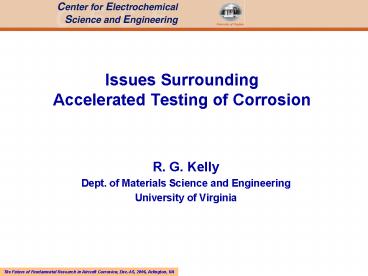Issues Surrounding Accelerated Testing of Corrosion - PowerPoint PPT Presentation
1 / 10
Title:
Issues Surrounding Accelerated Testing of Corrosion
Description:
Sea salt aerosols are not simply NaCl. There exists a rich ... Sea Salt Aerosols Have Strong Oxidizers Due to Interaction with UV and O3. Finlayson-Pitts (2002) ... – PowerPoint PPT presentation
Number of Views:54
Avg rating:3.0/5.0
Title: Issues Surrounding Accelerated Testing of Corrosion
1
Issues Surrounding Accelerated Testing of
Corrosion
- R. G. Kelly
- Dept. of Materials Science and Engineering
- University of Virginia
2
The Problem
- Salt spray testing methods of various flavors
have had limited success in predicting corrosion
damage in field - Rates
- Morphology
- Dependencies, e.g., alloy composition
- Connection to field use is challenging
- No fundamental framework to predict or
rationalize behavior
3
Example for Coatings Testing
- Comparison of Salt Fog, Prohesion, and Field
Results - Test of scribe creep for 20 different coating
formulations - Correlation is non-existent
- Similar experiences with other forms of corrosion
M. Hoeflaak, TNO Pub 040323 (2004).
4
Possible Origins of Disagreement
- Variability of atmospheric conditions and service
environments - Only rudimentary characterization of service
environments - Chemistry of surface solution is dynamic and
poorly characterized
5
Can Use Post-diction to Rationalize Behavior
Alclad 2024-T3 scribed, exposed to DAB for 12
months
AA 1230 clad AA 2024
Segment mounted for metallographic analysis
Find model conditions that best reproduce
observed behavior
Cui, et al. Corr J., (2006)
6
Abbott Field Observation 1 The Chloride Mystery
- Abbott at Battelle has measured effective Cl
distribution at land-base sites and in lab tests - Exposes silver coupon
- Galvanostatic reduction to determine Reactive
Chloride - Results
- Reactive chloride at all land sites tested
(highest in coastal areas, but measurable in
desert) - Virtually no production of AgCl in laboratory
Salt Fog
Abbott (2000)
7
Possible Reason
- Sea salt aerosols are not simply NaCl
- There exists a rich and complex chemistry
Keene, 2002
Finlayson-Pitts (2000)
8
Sea Salt Aerosols Have Low pH
- Small particles have lowest pH
- All pH lt 5
- Transported for long distances inland
Keene (2002)
9
Sea Salt Aerosols Have Strong Oxidizers Due to
Interaction with UV and O3
Molecular Halogens at Artic Polar Sunrise
O3
Br2
Irradiance
BrCl
Finlayson-Pitts (2002)
10
Atmospheric Solution Layer Chemistry is Far More
Complex than NaCl
- Interactions with atmospheric chemists appears
critical - Need to define aqueous chemistry on surfaces and
electrochemical behavior of materials in those
solutions - Information applicable across all forms of
corrosion when structure is exposed to
atmospheric conditions rather than full immersion































